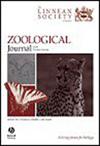A molecular phylogeny of Ceratophyllomorpha (Insecta: Siphonaptera): geographical distribution, origins, and host associations
IF 2.8
2区 生物学
Q1 ZOOLOGY
引用次数: 0
Abstract
From a taxonomic and systematic perspective, the order Siphonaptera is a neglected and overlooked group of insects. The classification of fleas is further hampered by a few classical taxonomic keys published over 40 years ago and, in many cases, they are not digitized and thus not easily accessible. More recently, molecular data have been utilized with great success in an attempt to resolve some of the higher level taxonomic uncertainties for Siphonaptera, but detailed phylogenetic studies of fleas are still scarce. Here we conduct a comprehensive phylogenetic and evolutionary review using 148 taxa within the infraorder Ceratophyllomorpha with 4689 aligned sites derived from seven different molecular markers. Bayesian phylogenetic analyses supported the monophyly of 34/48 genera (71%), and also supported the monophyly of most members within the Leptopsyllidae, Ceratophyllidae, and Ischnopsyllidae. The dated phylogeny constructed shows that diversification within the Ceratophyllomorpha dates back to ~23.1 Mya, and from this period onwards, the evolution of the fleas included herein was influenced by both host association and host distribution. The most common hosts of the Ceratophyllomorpha group were various families of rodents, with the exception of the Ischnopsyllidae, that was specific to the order Chiroptera. The rich extant Ceratophyllomorpha diversity is mainly confined to the Palaearctic region, and this geographic pattern was most evident for the family Leptopsyllidae. The present study emphasizes the need for a comprehensive taxonomic revision for the order Siphonaptera. Since the current taxonomic schemes are mainly based on morphology, future focus should be given to those species where no molecular data are available and where molecular data are scarce.角鼻虫亚目的分子系统发育:地理分布、起源和寄主关联
从分类学和系统学的角度来看,管翅目是一个被忽视的昆虫类群。跳蚤的分类进一步受到40多年前发表的一些经典分类密钥的阻碍,而且在许多情况下,它们没有数字化,因此不容易获取。近年来,分子数据已被成功地用于解决虹吸翅目更高层次的分类不确定性,但对跳蚤的详细系统发育研究仍然很少。本文利用7种不同的分子标记对角状植物亚目148个类群的4689个排列位点进行了系统发育和进化分析。贝叶斯系统发育分析支持34/48属(71%)的单系性,也支持Leptopsyllidae、Ceratophyllidae和Ischnopsyllidae中大多数成员的单系性。构建的系统发育年代表明,角鼻苔门内的多样化可追溯到~23.1亿年,从这一时期开始,本文所包括的跳蚤的进化受到寄主关联和寄主分布的双重影响。角翅目最常见的宿主是各种啮齿类动物,除了翼翅目特有的Ischnopsyllidae。现存丰富的角藻多样性主要局限于古北地区,这种地理格局在轻藻科中最为明显。本研究强调有必要对虹吸翅目进行全面的分类修订。由于目前的分类方案主要基于形态学,未来的重点应放在那些没有分子数据和分子数据稀缺的物种上。
本文章由计算机程序翻译,如有差异,请以英文原文为准。
求助全文
约1分钟内获得全文
求助全文
来源期刊
CiteScore
6.50
自引率
10.70%
发文量
116
审稿时长
6-12 weeks
期刊介绍:
The Zoological Journal of the Linnean Society publishes papers on systematic and evolutionary zoology and comparative, functional and other studies where relevant to these areas. Studies of extinct as well as living animals are included. Reviews are also published; these may be invited by the Editorial Board, but uninvited reviews may also be considered. The Zoological Journal also has a wide circulation amongst zoologists and although narrowly specialized papers are not excluded, potential authors should bear that readership in mind.

 求助内容:
求助内容: 应助结果提醒方式:
应助结果提醒方式:


